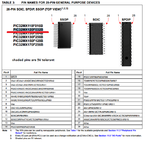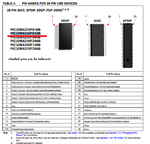K33rg4t3
Full Member level 3
Hello.
I have successfully programmed PIC32MX120F032B chip with my PICKIT2 clone and custom software and I have managed to do stuff like LCD and motor driving with it.
I have used 5V tolerant PGD/PGC pins because my PICKIT2 clone is not able to provide 3V levels ~ on PGD/PGC lines.
The MCLR voltage was also around 5V.
Now I am going to program PIC32MX220F032B, but it turns out that (according to datasheet) it has no 5V tolerant PGD/PGC pins!
Here is the comparison:


So now I am asking you guys, how can I get around this trouble? Do I understand correctly that MX220 version MUST be programmed with PGD/PGC signals at 3V level instead of 5V level like the MX120 version?
Is there any simple DIP chip that will convert 5V logic levels from my PICKIT clone to the 3V logic levels acceptable by MX220?
What is the direction of PGD and PGC lines? I assume that one is read and second write, but who knows?
Any suggestions appreciated!
I have successfully programmed PIC32MX120F032B chip with my PICKIT2 clone and custom software and I have managed to do stuff like LCD and motor driving with it.
I have used 5V tolerant PGD/PGC pins because my PICKIT2 clone is not able to provide 3V levels ~ on PGD/PGC lines.
The MCLR voltage was also around 5V.
Now I am going to program PIC32MX220F032B, but it turns out that (according to datasheet) it has no 5V tolerant PGD/PGC pins!
Here is the comparison:


So now I am asking you guys, how can I get around this trouble? Do I understand correctly that MX220 version MUST be programmed with PGD/PGC signals at 3V level instead of 5V level like the MX120 version?
Is there any simple DIP chip that will convert 5V logic levels from my PICKIT clone to the 3V logic levels acceptable by MX220?
What is the direction of PGD and PGC lines? I assume that one is read and second write, but who knows?
Any suggestions appreciated!